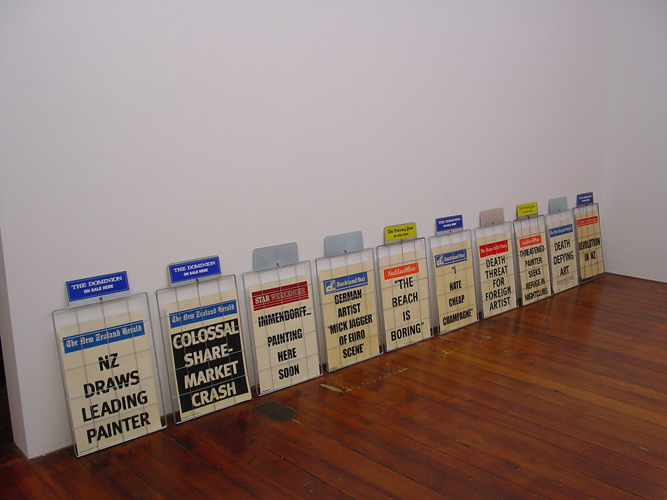Auckland Art Gallery News, June–September 2003.
Michael Stevenson’s recent archival research projects uncover bizarre links between art history and social history, between micro and macro-histories. Can Dialectics Break Bricks?, at the 2002 Biennale of Sydney, considered the role contemporary art played in the 1979 Iran Hostage Crisis. Stevenson’s project for the upcoming Venice Biennale, This Is the Trekka, will address the Trekka, New Zealand’s supposedly homegrown vehicle, in relation to Cold War cultural politics in the late 1960s and 1970s.
Stevenson’s first archival project, Call Me Immendorff, debuted at Berlin’s Kapinos Gallery in 2001. Stevenson investigated Jorg Immendorff’s 1987–8 Auckland visit. The German neo-expressionist painter spent three months in town inaugurating the Auckland Art Gallery’s international artist-in-residency programme. Immendorff was bankable: a world famous, blue-chip artist with impeccable political credentials. But holidaying in the provinces he happily degenerated into caricature. Manly but flamboyant, and laden with jewellery, Immendorff drank heavily, but only the finest wines, and womanised similarly. He became the crown prince of the local yuppie ‘Krug ’n’ cray’ set, just as its disposable income was being decimated by the stockmarket crash. A rock star among artists, Immendorff’s Auckland revels were brought to a similarly abrupt halt. In January 1988, a gift-wrapped package was left on his Albert Park doorstep. It contained a slayed rabbit, an expired bird, and a skull-and-crossbones postcard bearing the message ‘Expiry date 23.1.88’. It was taken as a death threat and the spooked artist was whisked off to a luxury hotel.
Stevenson’s Kapinos exhibition recreated the ensuing media circus. A protest banner–‘Ich Hasse Schwache Kunstler’ (I hate weak artists)—hung outside the gallery. Inside, forged newspaper newsstand posters carried similarly cliched sentiments (comments the artist had made to the press) alongside references to the stockmarket crash and the fall of the Berlin Wall (both of which would impact on Immendorff’s standing and relevance). A suite of facsimile drawings meticulously reproduced sensational newspaper clippings about Immendorff’s visit. A television documentary on the artist’s Auckland jaunt got an undeserved rerun, looking like an artworld sequel to This Is Spinal Tap. Viewers could only wonder: is this for real? Stevenson’s archival expose addressed provincial misrecognition. New Zealand’s desire to experience an overseas art star was matched by Immendorff’s willingness to play along.
The project found a new relevance when it returned to the scene of the crime—the Auckland Art Gallery—for the 2002 Walters Prize. The Auckland installation had new components: Immendorff’s bed from the Albert Park flat, a détourned version of the gallery’s Immendorff in Auckland catalogue (its amended text rereading his residency work in terms of local references), an expanded series of newsstand posters, a new banner—‘I Hate Provincialism’—and several new drawings, (including one reproducing Immendorff’s hotel room-service bill, which Stevenson discovered in the Gallery’s dead files). Chartwell purchased two of the drawings—including Hotel Bill—and the banner, and the Gallery secured the full set of sixty posters. Between us, we now hold a major chunk of this telling project.
